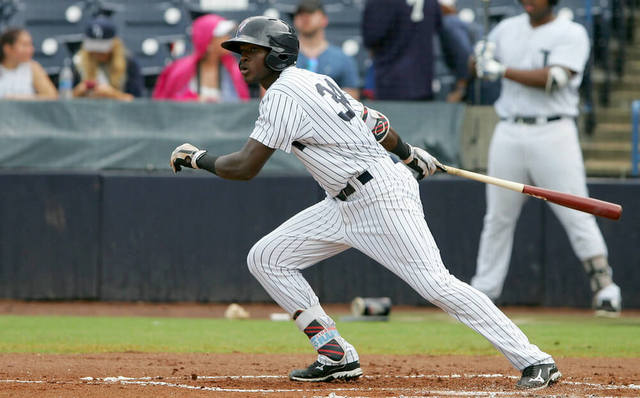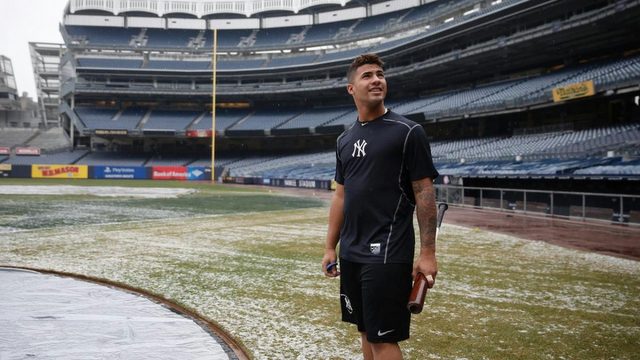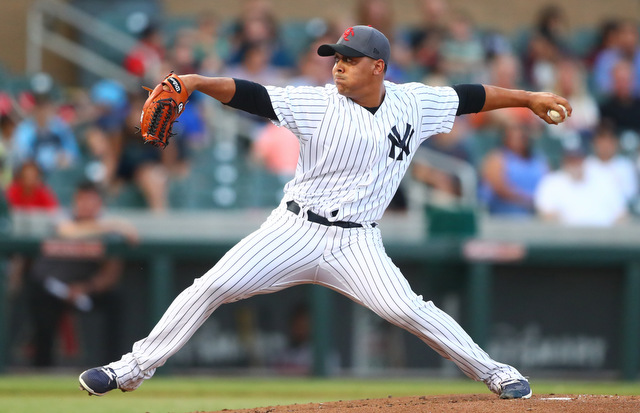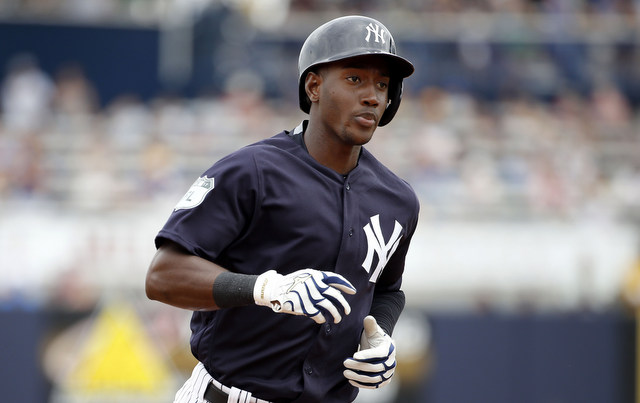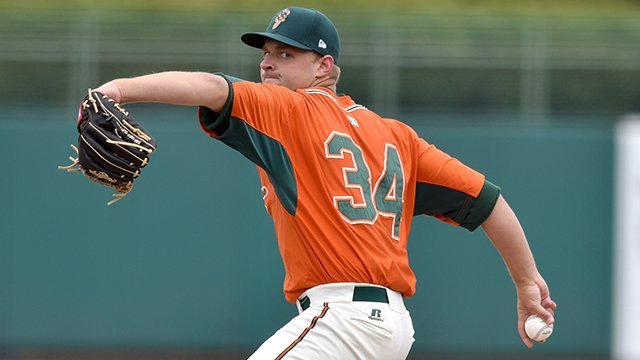
Two years ago the Yankees had arguably the top farm system in baseball. Uncharacteristically, they traded veterans for prospects at the 2016 trade deadline, and several of their own players took big steps forward with their development. Gleyber Torres came over in the Aroldis Chapman trade. Aaron Judge, Luis Severino, Gary Sanchez, and Miguel Andujar? All originally drafted or signed by the Yankees.
That monster farm system of two years ago has become a powerhouse MLB team. The Yankees surprisingly won 91 games in 2017, not-so-surprisingly won 100 games in 2018, and now they go into 2019 on the very short list of realistic World Series contenders. They’ve graduated or traded many top prospects, and have tumbled down the farm system rankings as a result:
- Baseball America: 20th
- Baseball Prospectus: 12th
- Keith Law: 19th
“Being ranked as everybody’s top farm system isn’t our goal. Our goal is to be ranked as winning the World Series,” said amateur scouting director Damon Oppenheimer to Greg Joyce last month. “… Everything’s a cycle in this thing. You get to a point where, if you’re going to try to win, you end up trading prospects. So we’ve traded quite a few guys over the last few years to help us acquire talent to help us win at the big league level, and that’s what we’re there to do. We’re in one of those cycles now where we gotta dump some more guys into the system.”
As the big league team contends this summer, the farm system will be in something of a rebuild, in that they have a plethora of young low minors prospects looking to take that step toward becoming the next wave of great Yankees prospects. The high-end upper minors talent isn’t there like it has been the last two years, and that could be an issue come trade deadline time. Time to preview the year ahead in the farm system.
Top Prospects Who Could Help This Season
There is only one: RHP Jonathan Loaisiga. In fact, the Yankees’ No. 2 prospect is set to join the rotation in a few days, after CC Sabathia’s five-game suspension ends. That is almost certainly a temporary move with Sabathia due to return in mid-April and Luis Severino hopefully sometime in early-May. Loaisiga is going to join the Yankees soon though, and that gives him a chance to help the team and force the club to keep him around longer.
Of course, Loaisiga has a long injury history and very limited experience (184.1 career innings!), plus he has never thrown a pitch in Triple-A, so he would presumably benefit from some Triple-A time. I imagine he’ll be returned to the minors at some point. Loaisiga has a quality three-pitch mix as well as good control, plus he seems unflappable on the mound, which are good traits for a young pitcher. Point is, Loaisiga is the only high-end upper minors prospect we figure to see in the Bronx this year.
Top Prospects Who (Probably) Won’t Help This Season
OF Estevan Florial, the Yankees’ top prospect, will begin the season on the injured list after breaking his wrist crashing into the outfield wall this spring. I suppose the good news is he’ll only be in a cast three weeks, meaning his recovery may not be as long as you’d expect. Three weeks in a cast seems to indicate he could be back in games sometime in May. That would be ideal. We’ll see.
The injury is unfortunate because Florial has a clear flaw in his pitch recognition — “I’m a young player. It’s tough to know what pitch to select. Try to know the pitch I can drive, and what I can’t, too,” Florial said to Brendan Kuty last month — and the only way to improve on that is with game reps. There’s no substitute for seeing live action pitching. Florial missed time with wrist surgery last year, so he has a lot of catching up to do. Once healthy, he’ll likely go to High-A Tampa or Double-A Trenton. Either way, we won’t see Florial in the big leagues this summer.
After Florial and Loaisiga, the next five best prospects in the farm system are all teenagers: C Anthony Seigler, OF Everson Pereira, OF Antonio Cabello, RHP Deivi Garcia, and RHP Roansy Contreras. On one hand, hooray for having so many very talented teenagers. On the other hand, none of those guys will come close to sniffing the big leagues. Seigler, Pereira, and Cabello may not even see full season ball this year, and Contreras could spend the entire season with Low-A Charleston.
Garcia made one Double-A spot start at the end of last season but he is unlikely to start this season at that level. Not after making only six (excellent) starts with High-A Tampa. Seems to me Deivi will return to Tampa for a few weeks before being bumped back up to Trenton. His best case scenario will be a late-season cameo with Triple-A Scranton. If we see Garcia in the big leagues this year, either something went very right (he really broke out) or very wrong (everyone got hurt).
Secondary Prospects Likely To Help This Season

The Yankees will have at least one of their non-top prospects on the Opening Day roster. LHP Stephen Tarpley, who pitched well last September and was great this spring, will be in the bullpen. He definitely has a chance to carve out a long-term role this summer. In all likelihood though, Tarpley will ride the shuttle up and down a few times. That’s just how it goes for a young reliever with options, especially when he’s the last guy in the bullpen.
Another reliever we could see at some point: RHP Domingo Acevedo. Lindsey Adler says Acevedo pitched in relief in minor league camp this spring and the Yankees wouldn’t do that unless he was moving into the bullpen full-time. I’m definitely down with this. Acevedo has struggled to stay healthy as a starter and he still hasn’t developed his slider into a reliable third pitch. Let him air it out for an inning at a time with the big fastball (and changeup) and there’s a chance very good things will happen. I’m looking forward to seeing Acevedo in short relief stints.
RHP Chance Adams and RHP Mike King are the top two Triple-A depth starters at the moment, though King suffered a stress reaction in his elbow early in camp, and is still working his way back. He’s expected to join the RailRiders in early May. Once he does, King could jump ahead of Adams on the call-up list. He had a monster 2018 season statistically and, at least prior to the injury, had firmer stuff and control than Adams, who’s taken a step back the last two seasons. Still, Adams is on the 40-man roster, so we’ll see him work shuttle duty at some point.
Double-A hurlers RHP Trevor Stephan, RHP Garrett Whitlock, and RHP Nick Nelson probably will not see the big leagues this summer. They’re not on the 40-man roster yet — Stephan and Whitlock don’t have to be added to the 40-man until after next season — and there are a few guys ahead of them on the depth chart, but, anytime you begin the season in Double-A, you have a chance to play in MLB. They will, they do. Pitch well in Double-A and they’ll find themselves in Triple-A in short order, and force a call-up conversation.
The Mike Tauchman pickup and Tyler Wade demotion makes it less likely we will see IF Thairo Estrada this year, or at least see him anytime soon, especially after a lost season last year. A few weeks (months?) worth of at-bats with Triple-A Scranton is what Estrada needs right now, but, if the Yankees have a need at the MLB level and he’s the best option, they will call him up. I imagine we’ll see Thairo as at least a September call-up this summer.
Breakout Candidates
This is where all that young low minors talent comes into play. Guys like Seigler, Pereira, Cabello, and Contreras are prime breakout candidates who could put themselves into the top 100 prospect discussion after the season. (Deivi broke out last year, I’d say.) Pereira and Cabello in particular are very high upside players who could very well rank 1-2 in the farm system in a few months. They’re that good and that talented.
This year’s Pereira and Cabello, meaning the highly regarded international signings set to make their pro debut, should be OF Kevin Alcantara and RHP Osiel Rodriguez. Alcantara ($1M bonus) stood out for his hitting ability when he signed and he’s already growing into some power. Rodriguez ($600,000) boasts a deep power arsenal and, like many Cuban pitchers, he throws from a variety of arm angles to create deception.
A few levels higher, the Yankees are finally set to turn 2017 first round pick RHP Clarke Schmidt loose. He returned from Tommy John surgery last year and pitched well in limited action. The Yankees will not be reckless with Schmidt — they don’t have him penciled him for 180 innings or anything — but he’ll finally get a chance to hold down a rotation spot and show what he can do. He’s been an afterthought since being drafted because of the Tommy John surgery. Schmidt’s kinda like adding a new prospect to the system all together.
Second tier outfield prospects like OF Josh Stowers and OF Anthony Garcia may not have the pure upside that Pereira and Cabello offer, though they do bring a lot to the table. In Garcia’s case, that means a lot of power. A lot. He’s a switch-hitter who can hit the ball a mile from both sides of the plate. Stowers is more well-rounded and will impact the game a lot of different ways. Offensively, defensively, on the bases, etc. He strikes me as a sneaky good breakout candidate.
Between international free agency and trades (Gil, Stowers, and Then were all acquired in trades), the Yankees have stocked the lower levels of the minors with exciting talent, and it was all by design. They picked up these kids very early in their careers — over the winter they traded for a pitching prospect yet to appear in a pro game — and will try to develop them into the next wave of top prospects. That’s the plan. The farm system may lack upper minors talent. In the low minors though, forget it. The Yankees are stacked, and that equals a small army of breakout candidates.
Returning From Injury
Technically, RHP Albert Abreu finished last year healthy, though injuries have given him trouble since coming over from the Astros in the Brian McCann trade. The power four-pitch mix is impressive. The lack of control and lack of durability are not. More than anything at this point, Abreu needs reps so he can work on refining his game. A full healthy season would be welcome in 2019. It could also land him a big league call-up at some point.
RHP Freicer Perez is a more traditional injury comeback story. He made six ugly starts last season before undergoing season-ending shoulder surgery. The good news? Perez only had bone spurs removed. His labrum, rotator cuff, and capsule are all intact. A lost season is a lost season though, and this year Perez will look to get back on track with a healthy shoulder. He went into last year as one of the top prospects in the system. Getting back to that level after shoulder surgery remains possible.
The forgotten pitching prospect in the system is RHP Glenn Otto, the Yankees’ fifth round pick in 2017. He made two starts with Low-A Charleston last year before having season-ending surgery to remove a blood clot from his shoulder. Yikes. When healthy, Otto showed a good low-to-mid-90s fastball with a hammer high-spin curveball that is seemingly allergic to bats. There were questions about his durability and changeup even before the surgery, but, even if Otto is a reliever long-term, he could be a good one. His coming out party is set for this summer.
Make or Break Year?

The 2014-15 international spending spree, while well-intended, has worked out very poorly. Florial is far and away the best prospect to come out of that signing class and he was a small bonus guy later in the signing period, not a headliner. Many of those 2014-15 kids have already washed out. Others, like 3B Dermis Garcia and SS Hoy Jun Park, still have some prospect value. Not much, but some.
Garcia’s calling call remains (and always will be) his power. He moved down the defensive spectrum to first base last year — apparently he’s going to give third base another try this year — and plans to turn him into a two-way player were apparently put on hold. Dermis did throw bullpen sessions late last season but he never appeared in a game as a pitcher. Alas. Garcia will move up to High-A Tampa this year after two seasons with Low-A Charleston. Another year of contact and defensive issues mean you can probably close the book on his days as a serious prospect.
After Florial, Park probably has the best chance to reach the big leagues among 2014-15 signees. He’s a very good defensive middle infielder who draws a lot of walks and can steal bases, but is short on power and exit velocity. Power is tough to project these days because of changes to the baseball, so perhaps we shouldn’t ding Park too much. He has a chance to rebuild some prospect stock with Double-A Trenton this year. The concern is advanced pitchers will knock the bat out of his hands. This is a big year for Park.
IF Kyle Holder has Major League ready defensive tools, but he hasn’t hit much in his career to date, and we haven’t seen much progress either. To be fair to Holder, he dealt with serious injury (broken vertebrae) and off-the-field matters (his brother passed away) last season, so we should cut him a break on the lack of development. That said, he is a soon-to-be 25-year-old defensive wiz with little to offer at the plate. Another year without much offensive progress and it’ll be time to look ahead to other infield prospects.
I think OF Isiah Gilliam has reached make or break status as well. He’s closing in on his 23rd birthday and saw marked declines in his power output, his walk rate, and his strikeout rate after moving from Low-A Charleston to High-A Tampa last season. As a non-elite bat-only corner outfielder, it doesn’t take much to get left behind. Gilliam has to rebound with a strong season this year, likely back with Tampa, to avoid becoming an afterthought.
Prospects I Am Excited About
Gosh, there are lots. Seigler, Pereira, and Contreras are at the top of the list. I also can’t give up on RHP Luis Medina yet, even after he walked 46 batters in 36 rookie ball innings last year. Medina turns only 20 in May, and he lights up the radar gun with his fastball and has a knee-buckling high-spin curveball, and I just can’t give up on that despite the extreme control problems. Medina’s going to be a long-term project and I am willing to be patient because the upside is so great.
OF Pablo Olivares has long been a personal favorite with his “do everything well but nothing exceptionally” skill set. RHP Frank German and RHP Tanner Myatt are two 2018 draftees I like for different reasons. German has already gained velocity as a pro and features a nice little slider. Myatt is a huge (6-foot-7) extreme hard-thrower (up to 101 mph) with an occasionally great curveball. He reminds me a bit of Kyle Farnsworth, which I know will drive some people nuts, but Farnsworth played 16 years in the big leagues as a late-inning reliever. That would be a heck of an outcome for an 11th round pick like Myatt.
Will The Yankees Trade Any Of These Guys?
Of course they will. The Yankees are a win-now team, so if when they need help at the trade deadline, they will trade prospects in an effort to get over the hump. They did it the last two trade deadlines and there’s no reason to think they won’t do it again this year. That’s the entire point of a farm system. To help address big league roster needs, either by graduating prospects to the show, or by using them as trade chips.
To me, Nelson stands out as a potential trade candidate. He will be Rule 5 Draft after the season and I get the feeling he falls into the same category as Dillon Tate and Josh Rogers last year. The “good prospect the Yankees don’t really know what to do with who is on the 40-man roster bubble” group. The other Double-A arms like Abreu, Stephan, Whitlock could all become trade candidates given the club’s lack of high-end Triple-A talent. Double-A starters are the next best thing.
Even before the injury, I don’t think the Yankees would’ve hesitated for a second to trade Florial in the right deal. Would they give him away? No way. But Florial is their best chance to acquire an impact player on July 31st. As long as he comes back from the wrist injury well, his trade value should remain intact. The Yankees professed their love for Justus Sheffield right up until they traded him. I could see the same happening with Florial.
The Yankees traded 15 prospects in the days leading up to the last two trade deadlines. Some were big names (Blake Rutherford, James Kaprielian, Jorge Mateo, etc.) and many were second and third tier guys (Josh Rogers, Billy McKinney, Luis Rijo, Zack Littell). I think the Yankees are at the point where no prospect is off-limits. I thought Gleyber Torres was untouchable as it gets two years ago. Now? There’s no one in the system like that. Not even close.
Where Does The System Go From Here?
Because the system is built mainly around pitching and very young low minors prospects, the Yankees have a boom or bust farm system right now. If the pitchers stay healthy and some of those teenagers figure it out, this could again be one of the top systems in baseball, and I mean as soon as next spring. The Yankees have gotten pretty good at developing players, thankfully. The chances of a farm system breakout in 2019 aren’t small.
Then again, if some of those pitchers get hurt — I have 18 pitchers in my top 30 prospects list and normal attrition suggests a few of them are going to feel something that requires a lengthy shutdown, that’s just baseball — and those teenagers need more than one or two pro seasons to hit their stride, the Yankees will again have a system ranked in the bottom half of the league next year. It’s not the end of the world, but a great farm system is a heck of a lot more fun than a mediocre one.
“I believe our system is one of the stronger ones in the game. It’s just the timing of everything. (The top talent) just happens to be at the lower levels. We are very pitching deep with a lot of high-end young arms,” said Brian Cashman to Randy Miller last month. “I’m not saying the system rankings are wrong. I will tell you this: As long as our guys stay healthy and develop the way we think they’re capable of developing, the system rankings are going to be radically different next year.”







